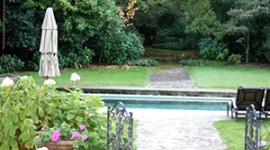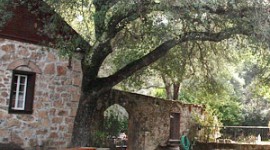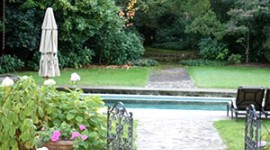Rare Napa Valley Landscape by Pioneering Modernist Thomas Church Under Threat
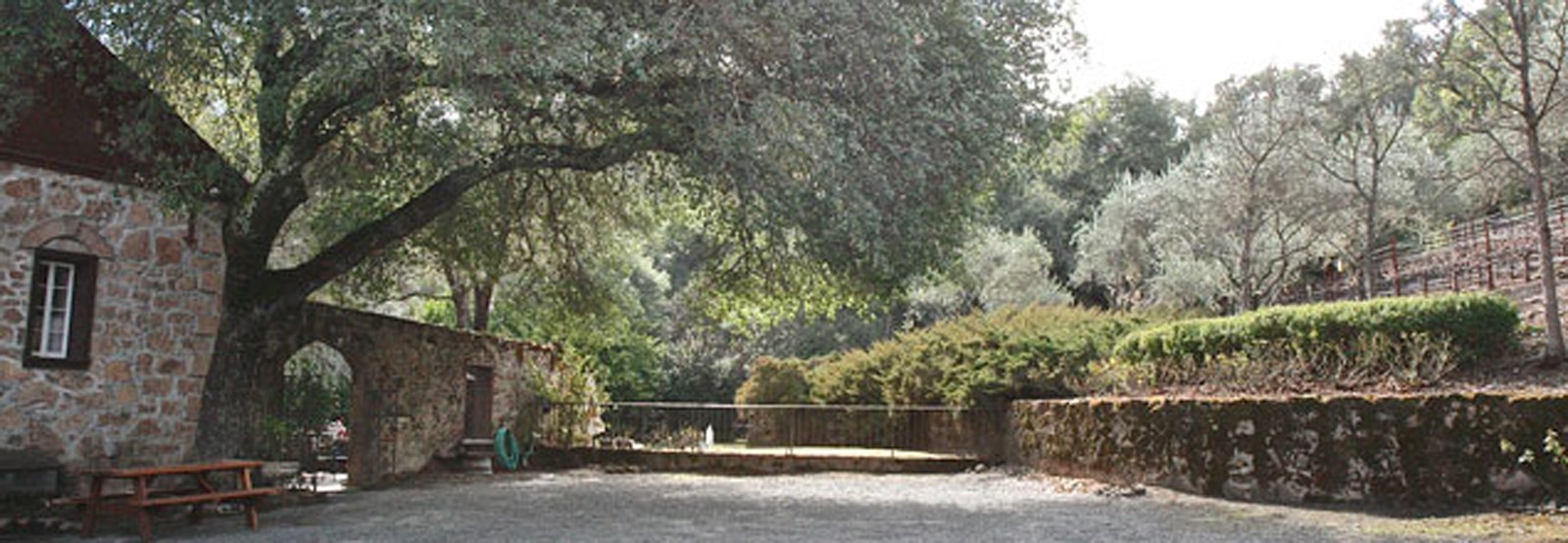
Napa Valley’s William Cole Vineyards, owned since 1999 by Bill and Jane Ballentine, includes landscape and gardens designed by the great Modernist landscape architect Thomas Church. For safety reasons, local officials are now requiring the Ballentines to widen the Church-designed service road – a move fire code consultants, engineers and preservationists say is unnecessary – or they will shut the winery down.
History
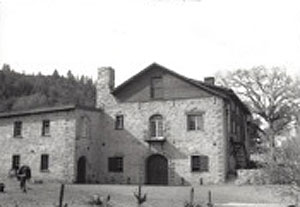
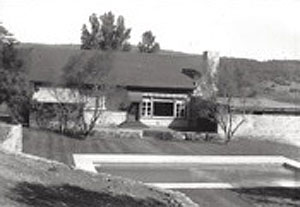
Vineyard in 1938, images courtesy Pam-Anela Messenger.In 1876 John Weinberger, an Ohio native, purchased a 240-acre estate in St. Helena, CA, where he settled with his family and founded the J.C. Weinberger Winery. He operated the business for only six years before a former employee murdered him. His widow Hannah continued the business, successfully operating the winery until the onset of Prohibition in 1920 forced its closure. The unoccupied estate gradually fell into disrepair until Maurice Harrison purchased it in 1938, five years after the end of Prohibition.
Harrison engaged noted San Francisco architect, F. Bourn Hayne, to renovate the existing Victorian-style house, which was in dire condition. Because of its poor state, the house was demolished and Hayne instead remodeled the upper floors of the stone winery (built with tufa stone from the Weinberger quarry) into the primary residence. Hayne recommended Harrison hire his Harvard colleague Thomas Church to design the home’s landscape.
The plan, which is a rare existing design for a vineyard by Church, contained many of his signature design elements – gently sweeping roads and paths, and careful grading. An entrance road led from the property’s edge at St. Helena Highway to the home, where a retaining wall was built to provide level terraces for a parking court, garden, lawn and swimming pool. At the west end of the court the lawn descended three feet into the garden where the entrance was originally flanked by apple trees.
The west garden was designed on axis with the house, with broad, low steps at the far end leading to a secluded seating area originally paved with redwood rounds (over time, these rotted and were replaced with flagstone). Behind the house, Church designed a 20 x 40-foot swimming pool. A pair of cypress trees flank the western edge of the terrace, adding to the symmetry of the design. Dense plantings surround the garden, creating a private enclave.
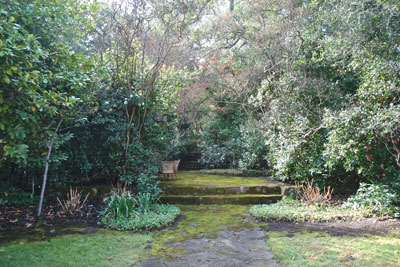
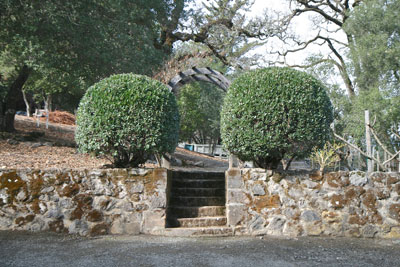
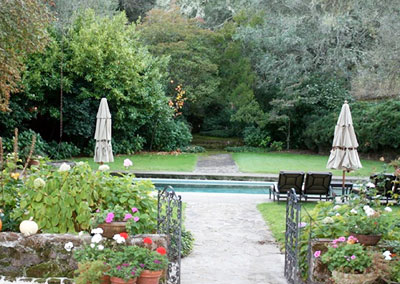
(upper) Photo by Pam-Anela Messenger; (middle) Photo by Pam-Anela
Messenger; (lower) Photo by Jane Ballentine.The Harrison family sold the property, and the landscape was neglected under subsequent ownership. The Ballentine’s have gone to great lengths to research the property, acquiring Church’s original Garden Study from 1938 (now framed and hanging in their foyer), as well as photographs taken when the Hayne remodeling was completed. They restored the winery to its original use in 2004, while still maintaining part of the building as their home, and are currently in the process of restoring the gardens.
Threat
The Ballentines’ restoration work has recently been halted by the Napa County Planning, Building & Environmental Services Department. County officials claim that for fire safety reasons the historically significant 14-foot-wide access road designed by Church must be replaced with a 20- foot-wide driveway. If the Ballentines fail to comply, the County will shut down the winery. Reports prepared by fire code consultants and engineers, as well as historic preservationists, conclude the driveway widening is unnecessary and would be detrimental to the historic integrity of the site. This driveway does not access the winery but does access the residence. The winery has an ample parking area just off the owners’ private access road with more than the required commercial hammerhead turnaround area. The widening of the existing driveway that leads from the parking area to the residence would not only be out of scale with the site, but would necessitate the removal of several oak trees and other vegetative screening. Additionally, because of the grade change, a retaining wall would need to be built.
The owners, supported by Napa County Landmarks, Inc., and research reports prepared by architects, fire code engineers, and others, want to preserve this unique site but need support.
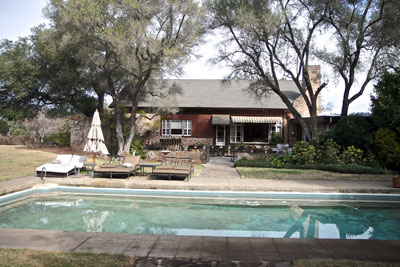
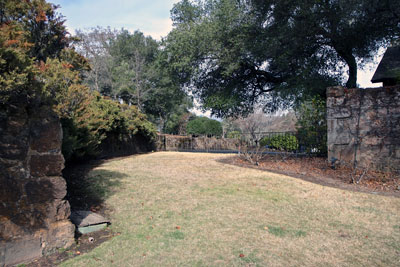
Photos by Pam-Anela Messenger.Under existing law, the property qualifies for protection and exemption from building modifications to comply with the County building code under the California Historic Building Code. However, Napa County’s Interim Director of Planning, Building & Environmental Services, Peter Parkinson, has stated that while the County recognizes the site’s historic nature, it will not grant an exception to their building and fire codes.
How to Help
Unless the county’s proposed 20-foot-wide driveway is built by February 17th, the winery will be shut down.
Letters in support of preserving the garden should be emailed immediately to:
Brad Wagenknecht - brad.wagenknecht@countyofnapa.org
Mark Luce - mark.luce@countyofnapa.org
Diane Dillon - Diane.Dillon@countyofnapa.org
Bill Dodd - bill.dodd@countyofnapa.org
Keith Caldwell - keith.caldwell@countyofnapa.org
John McDowell - john.mcdowel@countyofnapa.org
Peter Parkinson - peter.parkinson@countyofnapa.org
Update (February 18): Since the Landslide posting four days ago, county officials have promised to close the vineyard if the Ballentines fail to comply with the directive.
In order to protect the property from this fate the Ballentines have requested that the County apply the California Historic Building Code (CHBC) to the project which would allow them to propose alternatives to the plan in order to preserve the integrity of the historic property. In a letter sent to Napa County Landmarks (NCL) commission earlier this month, Napa County Deputy Planning Director John McDowell informed NCL that prior to utilizing the CHBC the Ballentines must first apply for modifications to the property’s zoning permit – a late-stage recommendation that counters earlier discussion between the owners and county officials. The use of the state mandated CHBC does not require a zoning permit prior to the review as these are separate issues. The importance of the property, according to Napa County Landmarks, is significant as it was recently determined as eligible for listing in the National Register of Historic Places, which the Ballentines are currently in the process of applying for with the California Office of Historic Preservation.
Update (February 19): The Napa Valley Register reports the Ballentines have temporarily shut down public visits and will seek to have the winery listed on the National Register of Historic Places.




